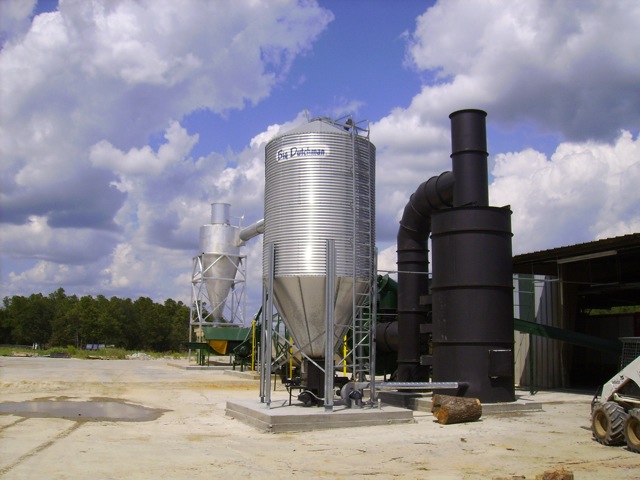

Jackson began selling Webb Burners® over 30 years ago, to answer the need for a more economical way of drying wood shavings. Since 2001, in cooperation with inventor and physicist William B. Webb, we have been manufacturing a complete line of biomass burners available in sizes from 1 million through 60 million BTU/hr. (Read more about this history here.)
These cyclonic suspension burners are ideal for generating large quantities of heat for industrial processes, at substantially less cost per BTU than traditional oil- or gas-fired systems. They may be fired with a variety of solid fuels including sawdust, corn cobs, sunflower hulls, flax shives, pelletized wood, charcoal, peat, and coal dust. Moisture content must be less than 15%, and particle size nominally 1/4" and smaller (commonly called "1/4 in. minus").
How It WorksFuel is augered out of the storage bin by the fuel feeder unit, and blown into the burn chamber. There, complete combustion occurs in semi-suspension in less than two seconds, resulting in emissions nearly equal to gas burners. There is no smoke (except when the fire is first lit), and carbon monoxide, VOC, SOx, or NOx emissions are very low. In addition, the extremely rapid combustion process allows quick response to changing process loads.
Hot gases from combustion exhaust into the hot gas transfer duct at the top of the biomass burner, and are drawn through the duct into the downstream process by induced draft fan(s) in the same manner as with a traditional fossil-fuel burner.
How It's MadeThe biomass burner is lined with an excellent combination of refractories to assure best heat retention and long burner life. The stack and hot gas transfer duct are lined with a high-temperature light weight insulating refractory. All steel surfaces are painted with high temperature anti-oxidant paint.
Can a Webb Burner® Use Green Fuel?In a word, no. It's because the Webb Burner® is very different from other types of biomass burners. The rapid combustion of fuel, in semi-suspension, is simply impossible to achieve with green fuel... because green fuel doesn't burn. It must get dry first, only then will it burn. This is the reason that a grease fire in the kitchen can be smothered by a wet towel -- the towel won't begin to burn until it has dried out.
Traditional biomass burners/boilers which are designed for green fuel have a burn chamber large enough so the fuel has time to release its moisture while making its way across the grate(s) or other surfaces, so it is able to kindle off when it reaches the flame zone. This traditional design makes it impossible to achieve the dynamic response to quickly changing process heat requirements which the Webb Burner® is capable of. It takes traditional biomass burners tens of minutes to make any substantial changes in their energy output. In many applications, such as space heating or district heating, this is acceptable. However, in demanding applications which cannot tolerate such slow response, a Webb Burner® is clearly the winning choice.
How Quickly Can a Webb Burner® Respond?Ramp time from low-fire to high-fire is less than 30 seconds, which rivals the typical performance of gas burners. In fact, during collaboration with Baker-Rullman Manufacturing on their pilot-scale mobile drying system, the same controls used for the LP burner were used to control a Webb Burner®, with absolutely NO CHANGES in configuration or setpoints; with excellent performance and perfectly stable operation.
This is why we don't need clumsy abort dampers or other heat-dumping devices between a Webb Burner® and the downstream process. If there is an urgent need to stop energy input to the process, we simply stop the flow of fuel, and within 2 seconds the fire goes out; just like a gas burner.
What About Controls?The Webb Burner® comes standard with a complete burner control panel, which provides automatic modulation of firing rate based on process outlet temperature (or other appropriate process parameter), and monitors burner and process inlet temperatures for safety shutdown in case of temperature extremes. It also has provisions for connecting to spark detection & extinguishing systems, as well as other related control systems. Controls are carefully designed to comply with the NFPA 664 and NFPA 85 industrial standards, for peace of mind and ease of compliance with insurance and fire regulations. They are manufactured by a UL-certified facility, and completed panels carry a UL listing (cUL or CSA available upon request).
The included control panel has all components and features which are needed for safe, proper operation; at a economical cost. However, a rich array of options are available, including touch-screen HMI, remote (off-site) monitoring, and integration with plant-wide PLC and control system networks.
A Final NoteThe first Webb Burner® was developed and installed by Mr. Webb in 1979, and there are many units currently in operation in various applications across the country and around the world. We will be happy to arrange a visit to see one in operation.
 Proposition 65 WARNING: Cancer and birth defects and reproductive harm - www.P65Warnings.ca.gov.
Proposition 65 WARNING: Cancer and birth defects and reproductive harm - www.P65Warnings.ca.gov.